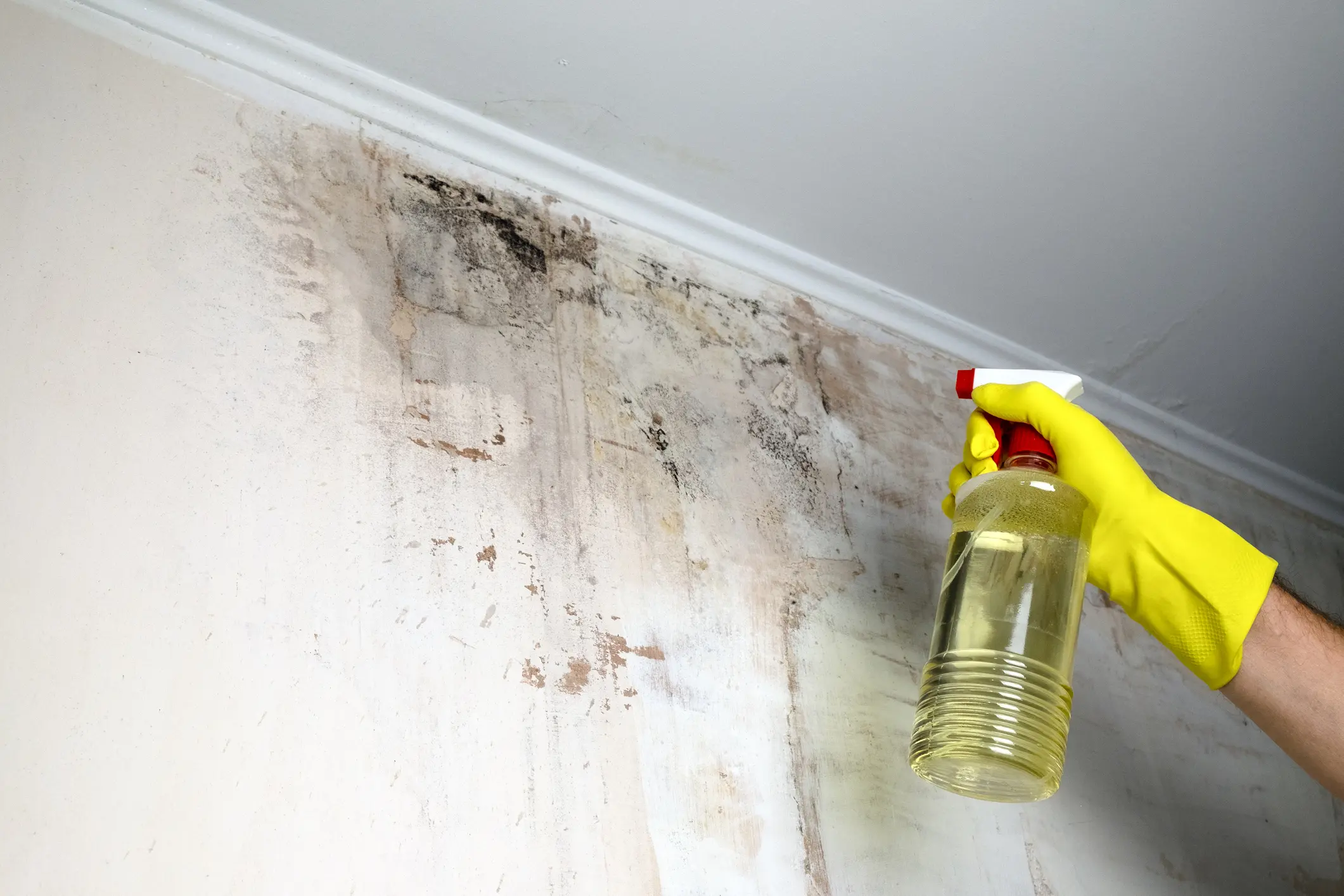
Water Damage on Ceiling: What Are the Signs & How to Fix It
Noticed flaking paint on your ceiling? Or perhaps brown water rings started formeing? These are the most common signs of water damage on ceiling.
Ceiling water damage might not seem like a big deal, but it could mean serious trouble. That little spot might be a sign of a leak or something else going on there. It could be your roof, pipes, or even just too much moisture in the air.
In this article, we will help you determine what is causing the water leak and give you the tips to fix the water damage before it turns into mold or even structural damage to your home.
What Does Water Damage Look Like On Ceiling?

Not sure if you’re dealing with water damage or something else? Here are the early signs of water damage on ceiling:
- Slightly discolored spots – if you notice any copper, yellow, or brown spots on your ceiling, they are a result of water damage.
- Peeling, flaking, or bubbling paint – if your ceiling paint started to peel, flake off, or bubble, that means water is getting into places it shouldn’t.
However, there are a few other signs that indicate you’re not dealing with just minor ceiling water damage. If you notice light brown circles on your ceiling, also known as water rings, that means water has pooled and dried out.
Musty smells are another obvious indicator you are dealing with water damage and potentially even mold. Mold loves damp spaces, so if you see it growing, especially in corners or edges, it’s time to act fast and prevent mold from spreading.
If your ceiling starts to droop or sag, you need to look for professional help immediately! That is a big red flag that water has been sitting up there for a while and can lead to serious structural damage to your home.
What Causes Water Damage on Ceiling?
If you see signs of water damage on your ceiling, don’t wait—act fast to stop things from getting worse. The tricky part is figuring out what’s causing it.
If the water-damaged ceiling is on the top floor, chances are it’s coming from your roof. It could be anything from damaged shingles to clogged gutters letting water sneak in.
But if there’s a room above the damaged ceiling, it’s likely a plumbing issue. Leaky pipes in bathrooms or kitchens can drip water onto your ceiling, sometimes so slowly that you don’t notice until there’s visible damage.
There are a few other potential causes of ceiling damage from water:
- Condensation:Â Attics and other poorly ventilated spaces tend to be very humid. Such surroundings allow condensation to build up over time. The moisture can eventually find its way to your ceiling, causing damage.
- HVAC issues:Â A leak in your HVAC system or clogged condensate drain line may also be a source of ceiling water damage.
- Leaky appliances:Â Dishwashers, washing machines, water heaters, and any other appliance that uses water can star leaking, causing damage to the floor and ceiling below them.
- Ice dams:Â If you live in a colder climate, it is possible for ice dams to form on your roof. Ice dams can trap water, which will then seep under the shingles and into your ceiling.
- Burst pipes: We’re mentioning this scenario just so you can rule it out. If you’re dealing with a burst pipe, there won’t be any subtle signs of water damage to your ceiling. The water will pour through and cause significant damage quickly.
Now that you know what does water damage look like on ceiling and what causes it, it’s time to help you deal with this issue.
How to Repair Water Damage on Ceiling
If you’ve discovered water damage on ceiling, there’s no need panic! In most cases, you can deal with the situation on your own. Here’s a step-by-step guide on fixing water damage on ceiling.
While it might seem overwhelming, you can handle the situation step by step. Here’s what to do.
1. Find the source of the leak
Now, this is where the previous section comes in handy. First, you’ll need to identify the source of the leak using the steps previously outlined. An inspection of the roof, attic, and plumbing may be necessary for you to properly determine the culprit behind the water damage.
2. Stop the water & fix source of the leak
The first and most important step is to stop more water from coming in. If it’s a roof leak, cover the area temporarily with a tarp. If it’s a plumbing issue, turn off the water supply to prevent more water from leaking out. This will help minimize further damage.
Then, you need to fix the source of the leak. If you’re handy, you may be able to do it yourself. But, if you’re dealing with complex repairs, you may need to bring in professionals to help with, for example, plumbing or roof repairs.
3. Assess the damage
Take a close look at your ceiling to figure out how extensive the damage is. Is it just a small stain, or is the ceiling sagging and soft to the touch? The level of damage will help you decide whether you can fix it yourself or if you need professional help.
4. Remove damaged material
If the ceiling is soft, sagging, or moldy, you’ll need to remove the damaged section. Use a utility knife to cut away the damaged drywall or plaster. Be careful not to damage any electrical wires or plumbing that might be hidden behind the ceiling.
Keep in mind that drywall absorbs water like a sponge, so you may need to cut a few inches away from the visible damage. Make sure to check the insulation above the drywall. If it’s wet, you may need to remove it as well.
For minor ceiling water damage, it can be enough to just let the spot dry and proceed with the repairs from there.
5. Dry out the area
Before you start any repairs, the ceiling needs to be completely dry. You can use fans, dehumidifiers, or even towels to soak up any moisture. This step is crucial because if you repair a wet ceiling, you risk trapping moisture inside, which can lead to mold growth.
Also, if everything is not dry, your repairs may not hold, or dampness might seep through your patched-up ceiling.
6. Repair the ceiling
Now it’s time to patch up the ceiling. If you removed drywall, cut a new piece to fit the hole and secure it with drywall screws. For plaster, you might need to apply a patching compound. Once the patch is in place, tape the edges and apply joint compound to create a smooth finish.
7. Prime and paint
After the patch is dry and sanded smooth, it’s time to prime and paint the area. Use a stain-blocking primer to prevent any water stains from bleeding through the new paint. Once the primer is dry, paint the ceiling to match the rest of the room.
8. Check for mold
Even after you’ve repaired the ceiling, keep an eye out for any signs of mold. If you notice any musty smells or see mold spots, you’ll need to address the issue immediately. Mold can spread quickly and cause health problems, so don’t ignore it.
9. Prevent future damage
Finally, take steps to prevent this from happening again. Check your roof for leaks, maintain your plumbing, and make sure your home has proper ventilation to avoid condensation buildup. Regular maintenance can save you from a lot of headaches down the road.
Who to Call to Fix Water Damaged Ceiling
When water seeps in, it can cause more than just a stain on your ceiling. It can compromise the integrity of your home, leading to bigger problems down the road.
You might be able to handle some repairs yourself, but keep in mind that water damage is often more complicated than it seems. What starts as a small, manageable spot can quickly become a much bigger issue if the underlying cause isn’t properly addressed. That’s why it’s crucial to call in professionals who know how to tackle water damage from all angles.
When deciding who to call, look for experts who understand the full scope of what water damage can do. You want a team that can not only fix the stains on your ceiling but also prevent future problems. The water damage restoration team you contact should be able to identify the source of the water, repair the damage, and restore your ceiling to its original condition—or better.
RAM Restoration Water Damage Restoration Process
When water damage strikes, you need a team you can trust to handle the situation quickly and effectively. That’s where RAM Restoration comes in. Our team comprises IICRC-certified professionals who know the ins and outs of water damage repair. From the moment you call us, we act fast, dispatching our team within 15 minutes of your call to assess the situation.
We start by identifying the source of the water, whether it’s from a burst pipe, a roof leak, or flooding. Once we’ve stopped the water, we move on to extraction, removing any standing water to prevent further damage. Our team then thoroughly dries out the area using state-of-the-art equipment, which helps prevent mold from taking hold.
But we don’t stop there. After the area is dry, we clean and sanitize everything, removing any debris and contaminants that may have been left behind. We also take care of any structural repairs that might be needed, restoring your home or business to its original condition.
Our team is dedicated to making the process as smooth and stress-free as possible, working with you every step of the way, including helping with water damage restoration insurance claims. When you choose RAM Restoration, you’re choosing peace of mind.
How to Prevent Ceiling Damage from Water?
Okay, now you’re fully equipped to deal with water damage on ceiling. But, we’d like to end off with a few tips that will prevent this scenario from happening in the future.
Here are some simple steps you can take to keep your home dry and your ceiling intact:
- Keep an Eye on Your Roof: Give your roof a quick check a couple of times a year. Look for anything out of place, like missing shingles or debris that could clog your gutters. This simple step can help keep water where it belongs—outside.
- Watch Your Pipes: Pay attention to your plumbing, especially in areas like under sinks or around toilets. If you spot a leak, don’t wait. Fix it before it turns into a bigger issue.
- Ventilate Your Attic:Â Make sure your attic has good airflow. This helps prevent moisture buildup, which can lead to water damage on your ceiling.
- Seal the Gaps:Â Check your windows and doors for any gaps or cracks. Sealing them up can stop water from sneaking in, especially during heavy rain.
- Control Indoor Humidity:Â If your home feels damp, use a dehumidifier. Keeping the humidity in check can stop condensation from causing problems on your ceiling.
- Clean Those Gutters: Don’t forget to clean out your gutters, especially in the fall. Clogged gutters can cause water to overflow and damage your home.
- Don’t Ignore Small Leaks: If you spot a small leak, deal with it right away. A quick fix now can save you a lot of trouble later.
Dealing with water damage or mold? Contact us today and let’s restore your home to its original state!

